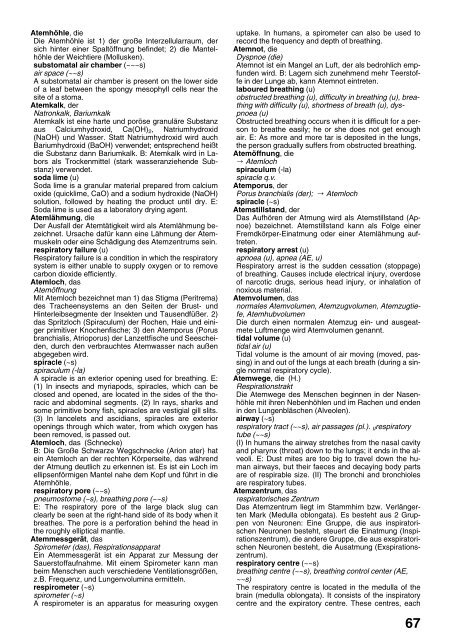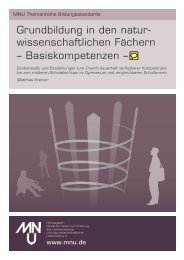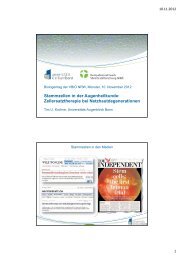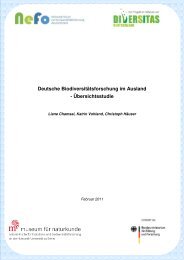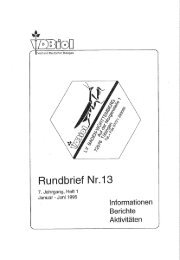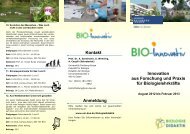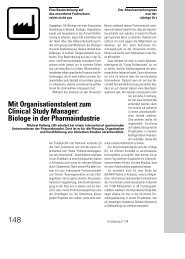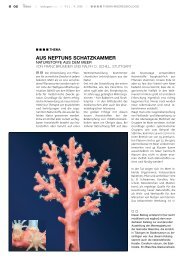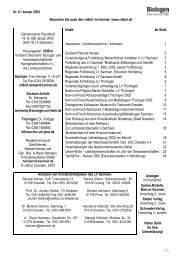Beispieldatei 1. Auflage BILI - VBio
Beispieldatei 1. Auflage BILI - VBio
Beispieldatei 1. Auflage BILI - VBio
Erfolgreiche ePaper selbst erstellen
Machen Sie aus Ihren PDF Publikationen ein blätterbares Flipbook mit unserer einzigartigen Google optimierten e-Paper Software.
AtemhoÈhle,die<br />
Die Atemhöhle ist 1) der groûe Interzellularraum, der<br />
sich hinter einer Spaltöffnung befindet; 2) die Mantelhöhle<br />
der Weichtiere (Mollusken).<br />
substomatal air chamber (~~~s)<br />
air space (~~s)<br />
A substomatal air chamber is present on the lower side<br />
of a leaf between the spongy mesophyll cells near the<br />
site of a stoma.<br />
Atemkalk, der<br />
Natronkalk, Bariumkalk<br />
Atemkalk ist eine harte und poröse granuläre Substanz<br />
aus Calciumhydroxid, Ca(OH)2, Natriumhydroxid<br />
(NaOH) und Wasser. Statt Natriumhydroxid wird auch<br />
Bariumhydroxid (BaOH) verwendet; entsprechend heiût<br />
die Substanz dann Bariumkalk. B: Atemkalk wird in Labors<br />
als Trockenmittel (stark wasseranziehende Substanz)<br />
verwendet.<br />
soda lime (u)<br />
Soda lime is a granular material prepared from calcium<br />
oxide (quicklime, CaO) and a sodium hydroxide (NaOH)<br />
solution, followed by heating the product until dry. E:<br />
Soda lime is used as a laboratory drying agent.<br />
AtemlaÈhmung, die<br />
Der Ausfall der Atemtätigkeit wird als Atemlähmung bezeichnet.<br />
Ursache dafür kann eine Lähmung der Atemmuskeln<br />
oder eine Schädigung des Atemzentrums sein.<br />
respiratory failure (u)<br />
Respiratory failure is a condition in which the respiratory<br />
system is either unable to supply oxygen or to remove<br />
carbon dioxide efficiently.<br />
Atemloch, das<br />
AtemoÈffnung<br />
Mit Atemloch bezeichnet man 1) das Stigma (Peritrema)<br />
des Tracheensystems an den Seiten der Brust-und<br />
Hinterleibsegmente der Insekten und Tausendfüûer. 2)<br />
das Spritzloch (Spiraculum) der Rochen, Haie und einiger<br />
primitiver Knochenfische; 3) den Atemporus (Porus<br />
branchialis, Atrioporus) der Lanzettfische und Seescheiden,<br />
durch den verbrauchtes Atemwasser nach auûen<br />
abgegeben wird.<br />
spiracle (~s)<br />
spiraculum (-la)<br />
A spiracle is an exterior opening used for breathing. E:<br />
(1) In insects and myriapods, spiracles, which can be<br />
closed and opened, are located in the sides of the thoracic<br />
and abdominal segments. (2) In rays, sharks and<br />
some primitive bony fish, spiracles are vestigial gill slits.<br />
(3) In lancelets and ascidians, spiracles are exterior<br />
openings through which water, from which oxygen has<br />
been removed, is passed out.<br />
Atemloch, das (Schnecke)<br />
B: Die Groûe Schwarze Wegschnecke (Arion ater) hat<br />
ein Atemloch an der rechten Körperseite, das während<br />
der Atmung deutlich zu erkennen ist. Es ist ein Loch im<br />
ellipsenförmigen Mantel nahe dem Kopf und führt in die<br />
Atemhöhle.<br />
respiratory pore (~~s)<br />
pneumostome (~s), breathing pore (~~s)<br />
E: The respiratory pore of the large black slug can<br />
clearly be seen at the right-hand side of its body when it<br />
breathes. The pore is a perforation behind the head in<br />
the roughly elliptical mantle.<br />
AtemmessgeraÈt, das<br />
Spirometer (das), Respirationsapparat<br />
Ein Atemmessgerät ist ein Apparat zur Messung der<br />
Sauerstoffaufnahme. Mit einem Spirometer kann man<br />
beim Menschen auch verschiedene Ventilationsgröûen,<br />
z.B. Frequenz, und Lungenvolumina ermitteln.<br />
respirometer (~s)<br />
spirometer (~s)<br />
A respirometer is an apparatus for measuring oxygen<br />
uptake. In humans, a spirometer can also be used to<br />
record the frequency and depth of breathing.<br />
Atemnot, die<br />
Dyspnoe (die)<br />
Atemnot ist ein Mangel an Luft, der als bedrohlich empfunden<br />
wird. B: Lagern sich zunehmend mehr Teerstoffe<br />
in der Lunge ab, kann Atemnot eintreten.<br />
laboured breathing (u)<br />
obstructed breathing (u), difficultyin breathing (u), breathing<br />
with difficulty(u), shortness of breath (u), dyspnoea<br />
(u)<br />
Obstructed breathing occurs when it is difficult for a person<br />
to breathe easily; he or she does not get enough<br />
air. E: As more and more tar is deposited in the lungs,<br />
the person gradually suffers from obstructed breathing.<br />
AtemoÈ ffnung, die<br />
? Atemloch<br />
spiraculum (-la)<br />
spiracle q.v.<br />
Atemporus, der<br />
Porus branchialis (der); ? Atemloch<br />
spiracle (~s)<br />
Atemstillstand, der<br />
Das Aufhören der Atmung wird als Atemstillstand (Apnoe)<br />
bezeichnet. Atemstillstand kann als Folge einer<br />
Fremdkörper-Einatmung oder einer Atemlähmung auftreten.<br />
respiratory arrest (u)<br />
apnoea (u), apnea (AE, u)<br />
Respiratory arrest is the sudden cessation (stoppage)<br />
of breathing. Causes include electrical injury, overdose<br />
of narcotic drugs, serious head injury, or inhalation of<br />
noxious material.<br />
Atemvolumen, das<br />
normales Atemvolumen, Atemzugvolumen, Atemzugtiefe,<br />
Atemhubvolumen<br />
Die durch einen normalen Atemzug ein-und ausgeatmete<br />
Luftmenge wird Atemvolumen genannt.<br />
tidal volume (u)<br />
tidal air (u)<br />
Tidal volume is the amount of air moving (moved, passing)<br />
in and out of the lungs at each breath (during a single<br />
normal respiratory cycle).<br />
Atemwege, die (H.)<br />
Respirationstrakt<br />
Die Atemwege des Menschen beginnen in der Nasenhöhle<br />
mit ihren Nebenhöhlen und im Rachen und enden<br />
in den Lungenbläschen (Alveolen).<br />
airway (~s)<br />
respiratorytract (~~s), air passages (pl.). IIrespiratory<br />
tube (~~s)<br />
(I) In humans the airway stretches from the nasal cavity<br />
and pharynx (throat) down to the lungs; it ends in the alveoli.<br />
E: Dust mites are too big to travel down the human<br />
airways, but their faeces and decaying body parts<br />
are of respirable size. (II) The bronchi and bronchioles<br />
are respiratory tubes.<br />
Atemzentrum, das<br />
respiratorisches Zentrum<br />
Das Atemzentrum liegt im Stammhirn bzw. Verlängerten<br />
Mark (Medulla oblongata). Es besteht aus 2 Gruppen<br />
von Neuronen: Eine Gruppe, die aus inspiratorischen<br />
Neuronen besteht, steuert die Einatmung (Inspirationszentrum),<br />
die andere Gruppe, die aus exspiratorischen<br />
Neuronen besteht, die Ausatmung (Exspirationszentrum).<br />
respiratory centre (~~s)<br />
breathing centre (~~s), breathing control center (AE,<br />
~~s)<br />
The respiratory centre is located in the medulla of the<br />
brain (medulla oblongata). It consists of the inspiratory<br />
centre and the expiratory centre. These centres, each<br />
67


